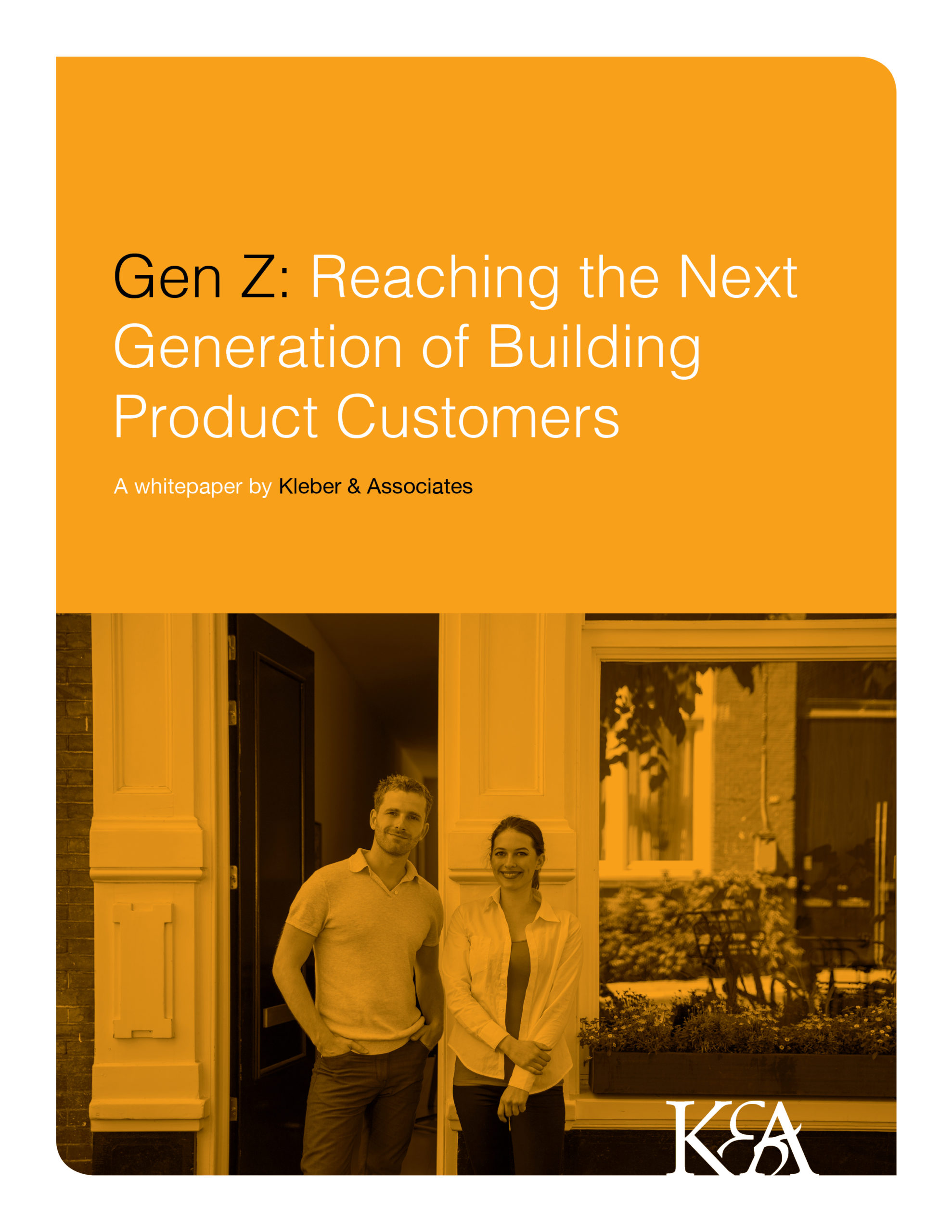Gen Z: Reaching the Next Generation of Building Product Customers
A white paper by Kleber & Associates
Reaching millennials — people born between 1981 and 1996 — has been a special project of businesses across the commercial spectrum for the past two decades. Having grown up during the dawn of the Internet Age, millennials have often been a tough nut to crack for building product companies and other traditional businesses. Millennials shop online more often, have access to more information prior to the sale than previous generations, and are likely to act on the word-of-mouth endorsement of friends rather than on traditional advertising.
As a group, however, millennials are more cash-strapped and debt-burdened than previous generations, with 61 percent delaying home purchases due to student debt, according to Business Insider. Many also find themselves trapped in the Great American Affordability Crisis — still reeling from aftermath of the 2008 Great Recession while dealing with a higher cost of living than previous generations.
For these reasons, many building product companies are starting to turn their gaze toward Gen Z consumers, or persons born after 1996. Entering the job market at a time when jobs are more plentiful and the economy is more stable, Gen Z represents a powerful and growing demographic. According to a recent PropertyShark report, home purchasing among Gen Zers is skyrocketing, with 83 percent of them planning to purchase a home within the next five years. From the second quarter of 2018 to the second quarter of 2019, the number of Gen Zers carrying a mortgage more than doubled from 150,000 to 319,000, illustrating many have their eyes on the prize of homeownership.
Knowing who Gen Zers are, what is important to them and how to effectively reach them will be critical for building product companies competing in the marketplace. This paper will discuss what makes Gen Z consumers unique, the challenges and opportunities for building product companies, and examples of effective outreach to this increasingly important consumer segment.
Who is “Gen Z”?
The Pew Research Center defines Gen Zers as anyone born in or after 1997. Generally, Gen Zers are understood to be individuals who became adults in the second decade of the 21st century and as of 2020 are in their mid-to-late 20s. Millennials — the preceding generation — had analog childhoods and digital adulthoods, while Gen Zers are fully digital natives. They grew up in a world of instant information through smart phones, 24-hour access to visual learning through platforms like YouTube and endless customization options. While millennials still have one arm in the past, Gen Zers haven’t experienced a world that wasn’t fully digital, connected and customized to their benefit.
Fintech lending, ride-sharing platforms like Uber and Lyft, and sophisticated work-from-home platforms were still in the development stages when many millennials were entering the workforce for the first time. Recent Gen Z grads have been using these tools to bypass many of the traditional barriers to homeownership – such as traditional mortgage lending, car ownership and living close to city centers where jobs are available but homes cost more.
Also helping Gen Zers is the economy, which has been growing at a rate of between 2 and 3 percent every year since 2010. When many millennials entered the workforce in the late 2000s, America was in the midst of the biggest economic crash since the Great Depression, influencing many to delay starting families and purchasing homes, while taking on more debt in pursuit of higher education and incomes. Experts suggest that in 15 years, Gen Zers will own more homes than millennials due mostly to aging into a more favorable economy and housing market.
Irene Williams, owner of the digital marketing and PR firm Msg2Mkt, recently spoke to Floor Covering Weekly and described the situation as such:
“[Gen Zers] may recall their parents facing the Great Recession in 2008/2009, and they’ve seen their older siblings swimming in college debt. They comprise the most ethnically and racially diverse generation the world has ever seen, and, representing upwards of 26 percent of the population, they outnumber other generational cohorts today. And it’s important to observe how Gen Z is completely unlike any other generation before it. Studies show Gen Zers are more pragmatic and realistic about their career paths than millennials, willing to put in additional effort to earn advancement and opportunities — even foregoing some work-life balance if it offers the meaningful reward of higher pay. They are more likely to save for homeownership with [the] intention to buy by the age of 30.”
The Ladders recently suggested the “housing crises of 2008 likely inspired a wave of financial literacy” among Gen Zers. Regulatory reforms in the wake of the financial crisis, such as the Dodd-Frank Wall Street Reform and Consumer Protection Act, have made it easier for consumers to understand and access information about their credit scores and investments, so Gen Z buyers are arguably in a stronger home buying position than previous generations.
Gen Zers vs. Millennials in the Marketplace
The habits of Gen Zers and millennials have many similarities, but diverge in certain important areas of concern to building product companies. Here are some similarities:
- Gen Zers and millennials face many of the same housing market realities. Arguably, Gen Zers sit in a better financial position than their millennial cohorts. According to Yahoo! Money, Gen Zers entering the workforce are earning a median of $616 a week, or $32,032 a year as of the end of 2019 — 30.5 percent more than millennials made at the beginning of 2009 when they were 20 to 24. However, Gen Zers can only afford a median of $160,600 for a home, well below the national median home value of $244,054. According to Realtor.com, between 2018 and 2019, the availability of entry level homes (priced under $200,000) decreased by 18 percent, limiting many to purchasing homes in the South and Midwest where property values are generally less. Gen Zers and millennials are both highly motivated to buy homes, but face significant challenges when it comes to available housing stock.
- Gen Zers and millennials demand more from companies than just reliable products. Thanks to the Internet, the world has gotten pretty convenient. Consumers are able to get high-quality, reasonably priced products delivered to their doors quickly, learn everything there is to know about those products through websites and reviews, and send products back if they are unsatisfied. In the case of building products, it is possible for the consumer to know more about the pros and cons of a product than the person installing it or the contractor recommending it. Young adults are also acutely aware if a product (or company) does harm to the environment. Ad Week suggests “solving consumer needs means something different today than it did 10 years ago,” and that simply building a better product “isn’t enough for world-wise Gen-Z and millennial change makers who are eager to be active participants in bettering our world.” Brands unwilling to aspire to a higher set of values than making money or having reliable products risk losing out to competitors.
- Gen Zers and millennials value personalization and brand loyalty programs. There’s a popular belief that younger adults are less loyal to brands and products than previous generations. Surveys among Gen Z and millennial consumers, however, suggest otherwise. While many millennials enjoy the convenience of shopping online versus in a brick-and-mortar store, Gen Zers and millennials respond surprisingly well to brand loyalty programs and personalized shopping experiences. According to Crowdtwist, a recent survey of consumers ages 18-37 showed that 75 percent of millennials and Gen Z are willing to share personal information in exchange for a personalized (brand-driven) experience and the majority of Gen Zers are already participating in at least one loyalty program. Seventy-one percent of millennials are also active in at least one program. The survey also suggests that brands should create personalized experiences, facilitate engagement across multiple channels (in-store, online, social and mobile), provide relevant loyalty rewards, and offer opportunities to earn loyalty program points through games and writing reviews.
Gen Zers, however, possess certain habits and expectations that set themselves apart from other generations:
- Transparency is the first step in establishing strong bonds with Gen Z. The Nielsen Company shows that millennials who came of age with the Internet have the highest levels of trust in online and mobile formats. This is not the case with Gen Z. According to Randall Beard, president of Nielsen Expanded Verticals, millennials “rely less heavily on traditional channels” than older generations, but “their trust and willingness to act on these formats remains high.” Gen Zers, who have come of age in an time of ‘fake news,’ deep fakes, and false social media advertising are more likely to look at traditional online advertising with suspicion and ‘call BS’ on advertising that is not authentic and personal. Gen Z has interacted with digital technology from birth and is extremely savvy when it comes to online advertising. They are more likely to buy a product or service based on a friend’s opinion rather than an online review because they understand testimonials and reviews can be faked and monetized.
- Gen Z is extremely frugal and practical. According to recent research from the University of Southern Indiana, only four in 10 millennials know what interest means in regards to lending and even fewer can define APR (annual percentage rate). Gen Zers on the other hand (along with Baby Boomers) score higher on tests of financial literacy than millennials and are more likely to have had conversation about finances and money with their parents. This may be influenced by predatory lending practices leading to the financial collapse of 2008, which ensnared many millennials, but served as a learning tool for Gen Zers. In many ways, Gen Zers are more aware of the implications of debt and overspending. In terms of home purchasing, they are more focused on convenience and proximity to job centers than home size. In terms of building products, they are less likely to agree to upsell purchases without fully understanding the long-term benefits.
- Gen Zers are extremely driven by individualization. Personalization is when brands create a tailored customer shopping experience based on appealing to the habits, behaviors and preferences of a known customer segment. A great example of personalization is the ‘Share a Coke’ campaign, in which Coca-Cola replaced its signature logo with common names, encouraging people to find their very own coke and share a coke with friends. Gen Zers value individualization, which is driven by the customer. Individualization allows customers to create unique, singular shopping experiences based on their own taste. An example would be a customization tool that allows buyers to create their own bathroom, kitchen or home and have it delivered and installed to their liking. Companies like Katerra are already moving in this direction, where people wanting to buy a home can say what kind of home they want, customize it to their liking and have it delivered/constructed according to their specifications. Gen Zers want to be active participants, collaborators and co-creators with brands. For building product companies, this may require a greater commitment to open dialogue and being responsive with customers.
Examples of Effective Gen Z Outreach among Building Product Companies
In the age of Instagram and LinkedIn, people are taking an active role in crafting their digital identities and are more conscious about the stories they create for themselves. This applies directly to home and building products. The homes people buy and the products they put on and in them tell a story about that person as much as any Instagram post. It makes sense that Gen Z customers want to have a greater role in the creative process. Here are some companies in the home and building products space that are meeting this challenge head on.
Hommatti – Viewing Homes from All Perspectives
www.homatti.com
Gen Zers value their time, prefer texts to phone calls and want to purchase a home to their liking with minimal human interaction. Hommatti embraces selling real estate to Gen Zers by fully embracing electronic processes and communication. Rather than taking time off from work and going door-to-door to home showings, Hommatti creates full-color, interactive maps of homes so potential buyers can tour dozens of homes from the comfort of their couch. They also have high-definition aerial videos of various properties that allow potential buyers to experience a property without having to be there. This kind of information allows the buyer to come to the agent with the home they want to purchase rather than buyers having to select from options picked by someone else (consumer-driven rather than brand-driven). It also sells an experience, rather than a product, which is an essential strategy for selling to Gen Z customers.
HOVER – Interactive 3D Modeling
Gen Zers appreciate customization and the ability to have a hand in the creative process of products that go in and on their homes. HOVER transforms smartphone photos into beautifully rendered and fully measured 3D models of any home. Using a virtual reality overlay, these interactive models allow designers and contractors to quickly show homeowners what certain exterior products and colors will look like on their actual home. Building product companies like CertainTeed utilize HOVER to show homeowners how particular roofing and siding products would look like on their home, helping the customer better visualize the final product. It also gives contractors detailed exterior measurements needed to quote an installation of a roof or siding replacement, eliminating the need for measuring tape. This helps the customer by letting them have a more active role in the product selection process and helps the contractor by helping them produce faster, more accurate quotes.
Modsy – Customizable Interior Design
Another platform that appeals to Gen Z customers is Modsy – a unique online interior design service that combines the expertise and personalization of working with a real designer with the power of virtual room design. With Modsy, the customer takes a few photos and measurements of the space they want to redesign and collaborate with an actual designer about their specific needs. The company will then provide 3D interior design ideas based on the customer’s space with furniture and decor they can actually buy on the spot. This allows Gen Z customers to maintain the role of secluded perfectionist, while getting unique products that fit their budget and style. Seeing your exact room, expertly designed in 3D with actual pieces of furniture from well-known retailers that you can buy on the spot is the perfect interactive sales funnel.
Effective Gen Z Strategies for Building Product Companies
While home affordability is a growing concern, the U.S. homeownership rate in 2020 has grown to 64.8 percent — not quite the all-time high of 70 percent reached in 2004 at the height of the housing bubble, but an increase from post-recession years. There is optimism in the market and with $44 billion of purchasing power, Gen Z consumers are well positioned to become a force in the housing market.
According to online advertising blog WordStream, millennials grew up during an economic boom and went into the housing market with a false sense of optimism. While millennials tend to be idealistic (short-term outlook), Gen Zers may be better-prepared home buyers as they were raised during a time of recession (long-term outlook). Gen Zers also value pragmatism and authenticity and will purchase building products wholeheartedly that help protect their finances and the environment.
Gen Zers are uniquely concerned about equality and human rights and let their purchases speak for them. They are also savvy enough to sniff out marketing ploys and insincere messaging. Here are some strategies that can help your brand make inroads with Gen Z customers:
- Have a purpose other than being profitable. Gen Zers are on the front lines of climate change and are very aware of the impact their purchases have on the environment. According to a recent study by the National Retail Federation and IBM, Gen Z is more concerned about the environment than any previous generation and 55 percent of Gen Zers choose brands that are eco-friendly and socially responsible. Having a highly visible corporate social responsibility (CSR) program and doing good may help your building products stand out from other products that just claim to be good.
- Sell the experience. Traditional building product advertising focuses on KSPs (key selling points) and how one product is better/faster/stronger/guaranteed longer than another product. Gen Z isn’t interested in the hard sale because they are inundated with advertising — on their phones, on their TVs, on their streaming radio services, etc. Breaking through to Gen Z often isn’t about saying how good a product will perform, but showing how it will improve their lives. Video is great for this. A video of a group of friends enjoying the unobstructed views from a cable rail deck or cozying around a new fire pit is a better way to sell those products to Gen Z than a stationary ad (print or digital) that simply extolls the virtues of a product.
- Use meaningful interactions to generate loyalty. Traditional loyalty programs sometimes fall flat with Gen Zers, who are used to instant access. If your loyalty program delays their gratification by making them rack up points or purchases, Gen Zers are not likely to wait around for the reward. Meaningful interactions often go much further. A good example is Sapporo, Japan’s oldest beer brewing company (established 1876). Every year, Sapporo invites brand evangelists and newsletter subscribers to company-sponsored “Legendary Journey” through Japan, visiting important sites including Sapporo’s famous German-style Beer Garden and its Beer Museum. For people who love the brand, continued loyalty can actually translate into a life-changing experience. Many building companies reach out to veterans, homeless prevention groups and cities to help transform the lives of regular people. ‘Going big’ on a small scale by making a major difference in the life of one loyal customer often goes further than small rewards for the masses.
- Micro-influencing often works better than celebrity endorsements. Impassioned micro-influencers can actually drive more engagement than celebrity influencers because Gen Zers find them to be relatable. Micro-influencers drive 60 percent higher engagement levels and 22 percent more weekly conversions — in addition to being nearly seven times more cost efficient per engagement compared to celebrity influencers, according to Medium. Carefully staged Instagram images may engender some interest, but a relatable, everyday hero showing how using your product brings them joy may carry more weight. Gen Zers want to be involved in the process, so giving customers insight into how products are made/installed as well as opportunities to offer input may be a useful tactic.
- Find ways to engage. Company reviews play an increasingly important role in building brand trust. A recent survey shows 76 percent of Gen Zers want brands to respond to feedback and view responsiveness as a demonstration of brand authenticity. Building product makers shouldn’t dismiss this phenomenon. Almost half of Gen Zers read at least five online reviews before making a purchase and share twice as much positive feedback as negative feedback, so it’s a good idea to find ways to solicit positive reviews. Companies also need to be proactive about responding to negative reviews. Public engagement should be genuine and ongoing.
Reaching the Gen Z market doesn’t require a lot of fancy tricks and convincing data. It requires genuine, proactive outreach that puts the customer in the driver seat. With a few tweaks, building product makers can take full advantage of this growing customer base.












